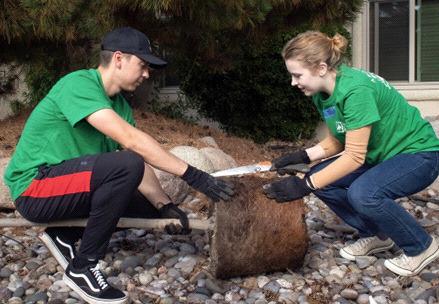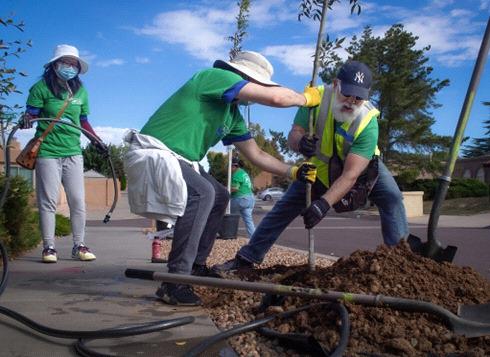We all love trees and they add so much to our lives. They add shade, fresh air, beauty, and improve health and wellness. They create a sound barrier and reduce noise pollution.
We need our trees and they are in trouble. The climate warming and decreased rainfall has stressed many of the trees that thrived in New Mexico. Right now the big effect we see is the bark beetle killing pine trees. In the cities and towns of New Mexico, look down your street: there is a big decrease in trees that used to line the streets. There is help for the trees. Organizations are stepping up to meet this challenge.
Tree statistics from Community Greening.org state that trees make a big difference in our live: 30% average saving in energy cost from properly, placed shade trees around a home. 10% temperature reduction compared to nonshaded areas. 7% increase in property values for homes with trees on the property. 22 pounds of CO2 are absorbed by a single mature tree each year.
Nature Conservancy used a climate modeling computer program to determine future climate zones for the United States. In New Mexico, they and other organizations have evaluated potential trees for adaptability to the changes in climate and have made recommendations for trees that would survive and thrive in the increased heat and drought. These are called “Climate-Ready Trees” and they can withstand the current cold snaps and heat and also thrive as temperatures increase over the next 100 years. It is predicted that Gallup and Grants climate zone will change from Zone 4-5 to Zone 7-8. That is Albuquerque’s zone. Albuquerque will be as warm as Las Cruses!
There are a number of New Mexico organizations that are focusing on this issue.
Tree New Mexico, the NM State Forestry, The Nature Conservancy, and numerous arboriculture experts are working on projects to increase the tree canopy and are focused primarily on the communities of New Mexico.
Tree New Mexico started planting trees in Albuquerque in 2017. They expanded their program last year to Las Cruces, Socorro, and Santa Fe. So far, they have planted 9,522 trees and have an 85% survival rate! The trees planted are 15-gallon trees for public areas and 5-gallon trees free for residents to plant. Their future plans include planting trees in Gallup and Grants. They educate people interested in trees to be Tree Stewards. Volunteers commit time to support tree health on sites such as city parks and help homeowners better care for their trees. They provide basic education in planting, pruning, and watering Climate-Ready trees. Tree NM trains the Tree Stewards in a 12-week program completed before volunteering and it makes a big difference in survival rate of the trees they plant.
Another program that can be accessed right now is Climate-Ready Trees. This program is administered by the State of New Mexico Energy, Minerals, & Natural Resources Dept. Forestry Division with other government and private agencies. The Nature Conservancy has evaluated potential trees species’ ability to adapt and tolerate New Mexico soil and climate. They are looking for demonstration sites to introduce these new species and to test them out. Nursery growers and the public will be able to see how well the new trees survive. They are offering a limited number of free trees to city governments and public schools that have public spaces that can become Climate-Ready Demonstration Sites. The application can be accessed online at Climate-Ready Trees New Mexico or contacting: Alyssa O’Brien, Urban and Community Forestry Program Manager, email: Alyssa O’Brien@emnrd.nm.gov
If you want to plant your own Climate-Ready tree, these are recommended for Grants and Gallup.
Short trees – below 40 feet suitable under powerlines, front yards, street sides.
Native to N. America Redbud, One-seed juniper, Rocky Mtn. juniper, Western soapberry, Gambel oak, (Osage orange & NM locust have thorns) Non-native – Mimosa, Smoke tree, Golden rain tree, Chinese pistache, Large trees – over 40 feet tall Native to N. America – Western Catalpa, Kentucky coffee tree, Alligator juniper, American sweet gum, Mx. sycamore, multiple oaks, Shumard oak, AZ cypress.
Non-native – Ginkgo, Afghan pine, Scotch pine, Japanese pagoda, Lacebark elm.
Fruit trees Quince, Fig, Apricot, Mx. Plum, Jujube
THINGS TO KNOW:
• Remember the mature height and spread of the tree, it will grow! Match tree characteristics to your site and needs. Consider overhead and underground utilities and proximity to buildings and walkways. Match your tree choice to the amount of upkeep and maintenance you can provide.
• All trees need to be watered as they put down their roots the first three to five years.
• Purchase quality trees. Even if it is a tough tree don’t purchase trees or shrubs with bugs, pests, or wounds.
• Proper planting will help your tree to survive. Remove all packaging (twine, pot, burlap), trim any circling roots, and plant the tree so the root flare is level with the soil.
• Mulch, mulch, mulch! This will help your tree retain water and protect is roots. Do not pile mulch on the trunk though!
Tree planting by Trees NM. Photo credit: Michael Payton


